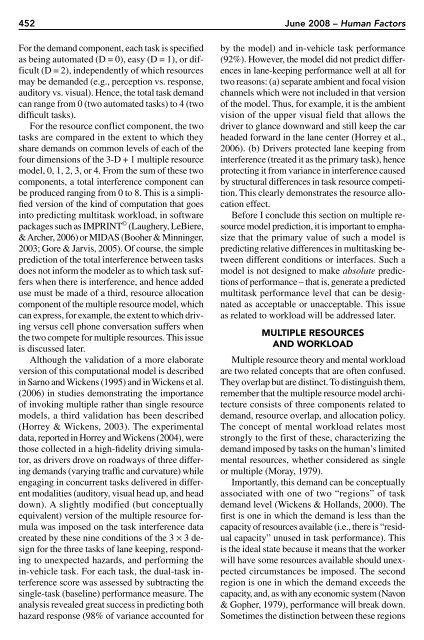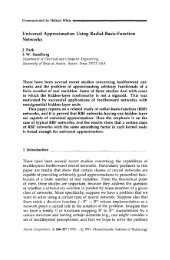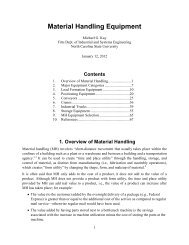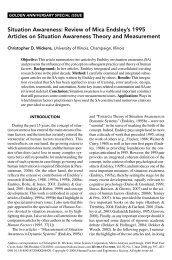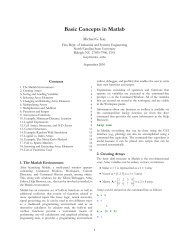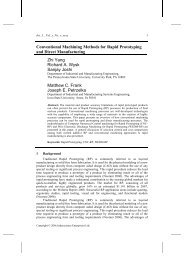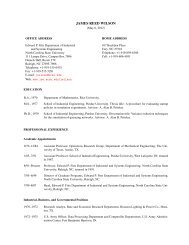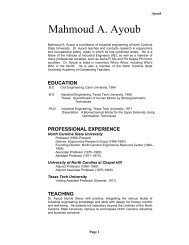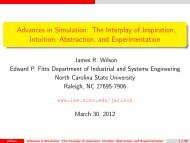Multiple Resources and Mental Workload - ResearchGate
Multiple Resources and Mental Workload - ResearchGate
Multiple Resources and Mental Workload - ResearchGate
Create successful ePaper yourself
Turn your PDF publications into a flip-book with our unique Google optimized e-Paper software.
452 June 2008 – Human Factors<br />
For the dem<strong>and</strong> component, each task is specified<br />
as being automated (D = 0), easy (D = 1), or difficult<br />
(D = 2), independently of which resources<br />
may be dem<strong>and</strong>ed (e.g., perception vs. response,<br />
auditory vs. visual). Hence, the total task dem<strong>and</strong><br />
can range from 0 (two automated tasks) to 4 (two<br />
difficult tasks).<br />
For the resource conflict component, the two<br />
tasks are compared in the extent to which they<br />
share dem<strong>and</strong>s on common levels of each of the<br />
four dimensions of the 3-D + 1 multiple resource<br />
model, 0, 1, 2, 3, or 4. From the sum of these two<br />
components, a total interference component can<br />
be produced ranging from 0 to 8. This is a simplified<br />
version of the kind of computation that goes<br />
into predicting multitask workload, in software<br />
packages such as IMPRINT © (Laughery, LeBiere,<br />
& Archer, 2006) or MIDAS (Booher & Minninger,<br />
2003; Gore & Jarvis, 2005). Of course, the simple<br />
prediction of the total interference between tasks<br />
does not inform the modeler as to which task suffers<br />
when there is interference, <strong>and</strong> hence added<br />
use must be made of a third, resource allocation<br />
component of the multiple resource model, which<br />
can express, for example, the extent to which driving<br />
versus cell phone conversation suffers when<br />
the two compete for multiple resources. This issue<br />
is discussed later.<br />
Although the validation of a more elaborate<br />
version of this computational model is described<br />
in Sarno <strong>and</strong> Wickens (1995) <strong>and</strong> in Wickens et al.<br />
(2006) in studies demonstrating the importance<br />
of invoking multiple rather than single resource<br />
models, a third validation has been described<br />
(Horrey & Wickens, 2003). The experimental<br />
data, reported in Horrey <strong>and</strong> Wickens (2004), were<br />
those collected in a high-fidelity driving simulator,<br />
as drivers drove on roadways of three differing<br />
dem<strong>and</strong>s (varying traffic <strong>and</strong> curvature) while<br />
engaging in concurrent tasks delivered in different<br />
modalities (auditory, visual head up, <strong>and</strong> head<br />
down). A slightly modified (but conceptually<br />
equivalent) version of the multiple resource formula<br />
was imposed on the task interference data<br />
created by these nine conditions of the 3 × 3 design<br />
for the three tasks of lane keeping, responding<br />
to unexpected hazards, <strong>and</strong> performing the<br />
in-vehicle task. For each task, the dual-task interference<br />
score was assessed by subtracting the<br />
single-task (baseline) performance measure. The<br />
analysis revealed great success in predicting both<br />
hazard response (98% of variance accounted for<br />
by the model) <strong>and</strong> in-vehicle task performance<br />
(92%). However, the model did not predict differences<br />
in lane-keeping performance well at all for<br />
two reasons: (a) separate ambient <strong>and</strong> focal vision<br />
channels which were not included in that version<br />
of the model. Thus, for example, it is the ambient<br />
vision of the upper visual field that allows the<br />
driver to glance downward <strong>and</strong> still keep the car<br />
headed forward in the lane center (Horrey et al.,<br />
2006). (b) Drivers protected lane keeping from<br />
interference (treated it as the primary task), hence<br />
protecting it from variance in interference caused<br />
by structural differences in task resource competition.<br />
This clearly demonstrates the resource allocation<br />
effect.<br />
Before I conclude this section on multiple resource<br />
model prediction, it is important to emphasize<br />
that the primary value of such a model is<br />
predicting relative differences in multitasking between<br />
different conditions or interfaces. Such a<br />
model is not designed to make absolute predictions<br />
of performance – that is, generate a predicted<br />
multitask performance level that can be designated<br />
as acceptable or unacceptable. This issue<br />
as related to workload will be addressed later.<br />
MULTIPLE RESOURCES<br />
AND WORKLOAD<br />
<strong>Multiple</strong> resource theory <strong>and</strong> mental workload<br />
are two related concepts that are often confused.<br />
They overlap but are distinct. To distinguish them,<br />
remember that the multiple resource model architecture<br />
consists of three components related to<br />
dem<strong>and</strong>, resource overlap, <strong>and</strong> allocation policy.<br />
The concept of mental workload relates most<br />
strongly to the first of these, characterizing the<br />
dem<strong>and</strong> imposed by tasks on the human’s limited<br />
mental resources, whether considered as single<br />
or multiple (Moray, 1979).<br />
Importantly, this dem<strong>and</strong> can be conceptually<br />
associated with one of two “regions” of task<br />
dem<strong>and</strong> level (Wickens & Holl<strong>and</strong>s, 2000). The<br />
first is one in which the dem<strong>and</strong> is less than the<br />
capacity of resources available (i.e., there is “residual<br />
capacity” unused in task performance). This<br />
is the ideal state because it means that the worker<br />
will have some resources available should unexpected<br />
circumstances be imposed. The second<br />
region is one in which the dem<strong>and</strong> exceeds the<br />
capacity, <strong>and</strong>, as with any economic system (Navon<br />
& Gopher, 1979), performance will break down.<br />
Sometimes the distinction between these regions


